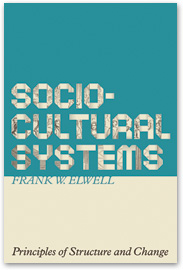
Sociocultural Systems: Principles of Structure and Change Macrosociology: Four Modern Theorists A Commentary on Malthus" 1798 Essay as Social Theory Great Classical Social Theorists In the Classical Tradition: Modern Social Theorists Dr. Elwell's Professional Page
|
rbert Spencer's Evolutionary
Sociology Gerhard Lenski | |
|
Lenski’s Evolutionary Theory
By Frank W. Elwell
Recall that the 9th Postulate of Lenski’s
ecological-evolutionary theory was that “societies evolve in response to
changes in their natural and social environments.” Sociocultural change
is of two types, innovation and extinction. The first involves adding
new elements such as technologies, social practices, institutions, or
beliefs to the system. The second type of change is, of course, the
elimination of old elements in the system. While extinction certainly
occurs, the process of sociocultural evolution is predominantly a
cumulative process, that is, change and innovation are added far more to
the system than older elements are eliminate. This, Lenski adds, is one
reason why sociocultural systems have grown more complex over time.
There are ultimately only three major factors determining the
characteristics of the so
Sociocultural change occurs as a consequence of individual members of
society making adaptive changes to their natural and social
environments. Of course, not all people have equal power in the decision
making process; “who decides” often depends on the nature of the choice
and one’s position in the stratification system. As a consequence many
important decisions are made by a few, and these few may well choose
alternatives that enhance or bolster their interests rather than the
interests of the total society. It is, after all, an imperfect social
system. Structural elites acting in their own interests therefore
provide positive and negative reinforcements for the adoption or
extinction of technological and social change. This feedback can often
be decisive in determining whether change is propagated throughout the
sociocultural system or whether it is extinguished.
Changes in subsistence technology (food, energy, and material
extraction) and population have far ranging consequences for human
The demographics of population, over and above sheer size, can also have
dramatic impact on the rest of the sociocultural system. Lenski
considers population and subsistence production critical in
understanding sociocultural systems because these two variables are the
principle means by which society regulates the flow of energy from its
environment. Increases in the food supply made possible by innovations
in subsistence technology is a necessary precondition for high
population levels, both of which are preconditions for significant
increases in the complexity of a society. The resulting complexity
creates many new problems for sociocultural systems, all of which call
for further technological, social, and cultural change.
Recall that enlightened self-interests of humans leads them to equitably
distribute goods and services to productive classes in order to ensure
their survival and continued productivity. However, any surplus is
likely to be divided in accordance with self-interest, that is, on the
basis of social power. This leads Lenski to the following hypothesis:
“The more intensive the subsistence technology, the greater the surplus,
the greater the surplus, the greater the inequality.”
As technology and productivity increases a portion of the new goods and
services will go toward necessary population growth and feeding a larger
population. However, with technologi
In his studies Lenski indeed finds increasing degrees of inequality up
to and including early industrial society. At this stage of development,
however, he finds the degree of inequality peaking and then beginning to
lessen as industrial society matures. In mature industrial societies the
lower social classes appear to materially benefit more than in agrarian
or early industrial societies both in absolute and relative terms.
Elites appear to receive less of a proportion of the nation’s income.
Lenski thus concludes that mature industrial societies represent a
reversal of a long-standing evolutionary trend in which inequality
increased with technological development. He linked the lessening
inequality to a variety of factors: 1) Necessity of a large
administrative and technical structure; 2) Satiation of elites (there
are only so much they can consume); 3) The buying of allegiance and
commitment of the middle and working classes in order to promote further
growth; 4) Changes in population and production dynamics; and 5) The
rise of ideologies that advocate more economic equality.
There is a process of selection in the world system that favors larger,
more powerful societies at the expense of smaller, less powerful ones.
Sociocultural change is largely a cumulative process which is the major
factor in the growth of the complexity and size of societies over the
course of human history. But to fully appreciate the process of
sociocultural evolution, you must recognize that it includes both
continuity and change. The vast majority of societies have experience
very little change over the course of their history. But in the global
system as a whole, societies have gotten larger, developed more
sophisticated methods of exploiting their environments, and developed
more complex divisions of labor.
This paradox has created some confusion. How can the global system of
societies change so radically, particularly in the last 10,000 years
when individual societies appear so resistant to change? The answer is
that social evolution ex
At the individual societal level, societies respond to changes in their
natural and social environments, which, in combination with their
distinctive histories, produces the innovative adaptations, some of
which get passed on to other societies within the global system and
become part of the inter-societal selection process. Sociocultural
evolution therefore operates on two distinct levels, within individual
societies and within the world system of societies. The two processes
combined determine “which societies and which cultures survive and which
become extinct, and the role that each of the survivors plays within the
world system.” For a more extensive discussion of Lenski’s theories refer to Macro Social Theory by Frank W. Elwell. Also see Sociocultural Systems: Principles of Structure and Change to learn how his insights contribute to a more complete understanding of modern societies.
References:
Elwell, F. (2009) Macrosociology: The Study of Sociocultural Systems.
Lewiston: The Edwin Mellen Press.
Elwell, F. (2013), Sociocultural Systems: Principles of Structure and
Change. Alberta: Athabasca University Press.
Lenski, G. (2005). Ecological-Evolutionary Theory: Principles and
Applications. Colorado: Paradigm.
Lenski, G., & Lenski, J. (1987). Human Societies: An Introduction to
Macrosociology (5th edition). New York: McGraw-Hill Book Company.
Lenski, G., Lenski, J., & Nolan, P. (1991). Human Societies: An
Introduction to Macrosociology (7th edition). New York: McGraw-Hill
Book Company.
Lenski, G. (1966). Power and Privilege: A Theory of Social
Stratification. New York: Random House.
To reference Lenski's Evolutionary Theory you should use the following format:
Elwell, Frank
W. 2013. "Lenski's Evolutionary Theory," Retrieved August 31, 2013 [use
actual date]
http://www.faculty.rsu.edu/~felwell/Theorists/Essays/Lenski2.htm
|
 ciocultural system: 1) Human’s genetic
heritage; 2) The biological, physical, and social environment; and 3)
The influence of prior social and cultural characteristics of the
society itself. The force of historical experience therefore plays a
major role in shaping social institutions and thought. The rate of
innovation and change varies across different societies. There are
several factors that influence this rate. 1) Store of existing cultural
information; 2) Population size; 3) Stability of the physical and
biological environment itself; 4) Contact with other societies; 5)
Character of the physical environment itself; 6) Attitudes and
ideologies toward change; and 7) Technological innovation itself
ciocultural system: 1) Human’s genetic
heritage; 2) The biological, physical, and social environment; and 3)
The influence of prior social and cultural characteristics of the
society itself. The force of historical experience therefore plays a
major role in shaping social institutions and thought. The rate of
innovation and change varies across different societies. There are
several factors that influence this rate. 1) Store of existing cultural
information; 2) Population size; 3) Stability of the physical and
biological environment itself; 4) Contact with other societies; 5)
Character of the physical environment itself; 6) Attitudes and
ideologies toward change; and 7) Technological innovation itself organization, cultural beliefs, and values. This configuration is, of
course, identical to Marvin Harris’s concept of
organization, cultural beliefs, and values. This configuration is, of
course, identical to Marvin Harris’s concept of
 cal development and subsequent
increases in productivity, a larger surplus of goods and services will
be produced. Lenski’s second hypothesis predicts that with technological
advance, an increasing proportion of goods and services available to a
society will be distributed on the basis of power. If true, then when
examining sociocultural systems we should see that the greater the
technological advance, the greater the inequality of goods and services
within the society.
cal development and subsequent
increases in productivity, a larger surplus of goods and services will
be produced. Lenski’s second hypothesis predicts that with technological
advance, an increasing proportion of goods and services available to a
society will be distributed on the basis of power. If true, then when
examining sociocultural systems we should see that the greater the
technological advance, the greater the inequality of goods and services
within the society. ists on two different levels, and these two
levels—individual societies and the global system of societies—follow
divergent evolutionary paths. At the global system level, there has been
a dramatic reduction in the number of societies in the last 10,000 years
due to a process of “inter-societal selection.” Societies that have
grown in size and technology have also grown in complexity and military
power; and this has allowed them to prevail in conflict over territory
and other resources with societies that have maintained more traditional sociocultural patterns. Successful adaptations are spread through social
contact, military, and economic conquest. Societies that adopted
innovations that led to increases in productive capacity, population
growth, structural complexity, and military power are those that have
survived to transmit their culture and institutional patterns.
ists on two different levels, and these two
levels—individual societies and the global system of societies—follow
divergent evolutionary paths. At the global system level, there has been
a dramatic reduction in the number of societies in the last 10,000 years
due to a process of “inter-societal selection.” Societies that have
grown in size and technology have also grown in complexity and military
power; and this has allowed them to prevail in conflict over territory
and other resources with societies that have maintained more traditional sociocultural patterns. Successful adaptations are spread through social
contact, military, and economic conquest. Societies that adopted
innovations that led to increases in productive capacity, population
growth, structural complexity, and military power are those that have
survived to transmit their culture and institutional patterns.